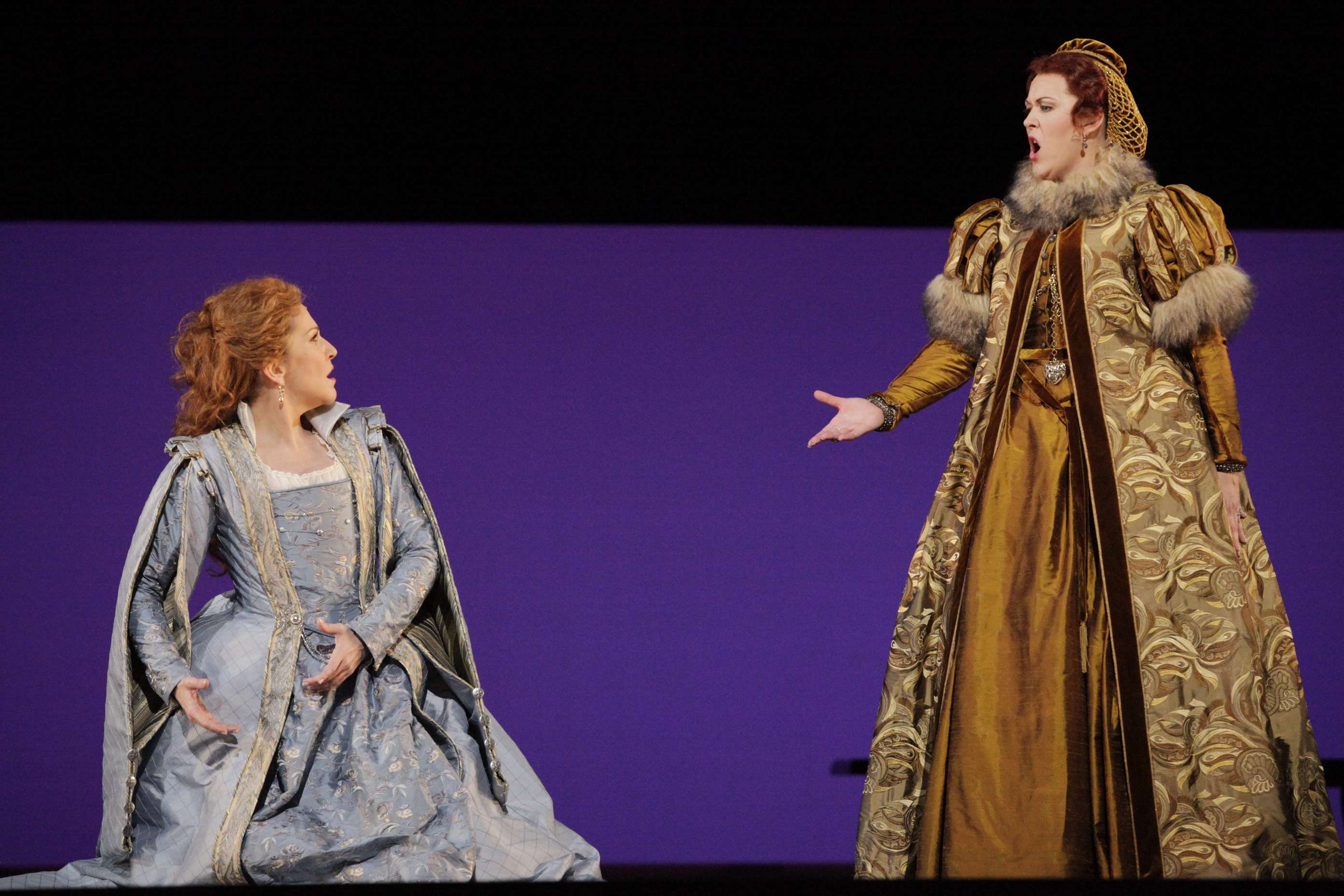|
Back
A Tale of Two Queens Houston
Brown Theater, Wortham Theater Center
04/21/2012 - and April 27, 29*, May 2, 4, 2012
Gaetano Donizetti: Maria Stuarda
Katie Van Kooten (Elizabeth I), Robert Gleadow (Talbot), Oren Gradus (Cecil), Eric Cutler (Robert, Earl of Leicester), Catherine Martin (Anne), Joyce DiDonato (Mary Stuart)
Houston Grand Opera Orchestra and Chorus, Patrick Summers (conductor)
Kevin Newbury (Director), Neil Patel (Set Designer), Jessica Jahn (Costume Designer), D. M. Wood (Lighting Designer)

J. DiDonato, K. Van Kooten (© Felix Sanchez)
Solely as an opera, Donizetti's Mary Stuart has little going for it. The opera is infamous on two counts: that it laid unperformed for over a century after its disastrous premieres in multiple versions, and that the singer tasked with Mary Stuart's role gets to call Elizabeth I a "vile bastard." The former fact is a result of the score's lack of any "hits", despite a few highlights here and there. The latter fact actually makes the opera more problematic, as it produces one of Donizetti's most dramatic scenes--imagine a nineteenth century Real Housewives series based in London, with two matriarchs coming close to pulling hair--that only heightens the lack of drama in the remainder of the opera. All of the secondary characters are flimsily written, and Mary Stuart is absent for the entirety of the first part of the opera, while Elizabeth disappears from the action somewhere in Act II.
Performances, then, rely on the star power of the two women cast in the main roles. Beverly Sills and Joan Sutherland are the names most often associated with the title role, and Joyce DiDonato, with her darker-hued but fully capable mezzo-soprano, easily lives up to those standards. Slight of stature but full of vocal adrenaline, she mines the role for as much depth as possible, limning a wonderful dramatic arc from her initial confrontation with Elizabeth I to her final, resigned acceptance of fate as she ascends the gallows. Most impressive is her breath control, and the phrases in "O nub! che lieve per l'aria" are wonderfully spun into infinity.
DiDonato is matched by a terrific performance by Katie Van Kooten in the challenging role of Elizabeth I. Van Kooten follows up her tremendous singing as Ellen Orford in last season's Peter Grimes, bringing a rich, honey-toned voice the eschews pride. She and DiDonato sing up quite a tempest in the confrontation in Fotheringhay Park, producing a climactic scene that comes far too soon in the progress of the opera. Likewise, the scene in her apartment shows her teetering between Cecil and Leicester in contemplating Mary's fate, and Van Kooten provides a solid yet emotionally complex axis on which the men turn.
The men's roles are slight, and the singing in this production is very good if not entirely distinctive. Eric Cutler has the most to do as Leicester, and he portrays the fragility of the character effectively. Oren Gradus' Cecil is a wonderful surprise, his rich bass surprisingly flexible. Robert Gleadow's Talbot produces a scene of true tenderness with DiDonato towards the end of the opera, making one wish that this relationship were more developed.
Set design is simple, yet smart. Modular decor drops from the ceiling to create diverse spaces, and simple bands of colored light in the background underscore the emotional progress of scenes and characters. Patrick Summers conjures expert playing from his instrumentalists and they are joined by the HGO chorus, singing with pinpoint diction, to produce perfectly coordinated set pieces.
Although the facile nature of the opera cannot be ignored, this is a pleasant night at the theatre, especially worthwhile for those following DiDonato's career development (this is a role debut for her, and she will reprise it at the Metropolitan Opera in 2013) as well as fans of Van Kooten's artistry.
Marcus Karl Maroney
|